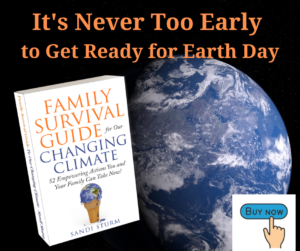Originally published in RVTravel.com
Every year it seems like our choices are increasingly limited as to where to find monthly stays. Scores of climate refugees are jumping into their RVs, if they are lucky to have one, and driving to safety. Others are fleeing to escape the dangerous heavy smoke, flooding, and other extreme weather conditions.
Personally, we have been impacted more by wildfires here in the western U.S. But let’s explore the impact a changing climate is having on RV travelers due to wildfires, flooding, and access to National Parks.
Wildfires
If you look at statistics from the National Interagency Fire Center back in the 80’s, you will see acreages burned between 1.1 million (1984) and 5 million (1989). Jump ahead to 2010’s and those numbers are between 3.4 million (2010) and 10.1million (2020). In 2021, California alone has had over 3 million acres burned.
We have been evacuated because of wildfires in the U.S. and Canada on many occasions and have driven through thick smoke for thousands of miles since our RV journey began in 2000.
While parked in a remote area along the Yukon River in the Yukon province of Canada, we had a knock on the door at 11 p.m. As a traveler you know you dread that unexpected sound. It was the Canadian Mounties telling us to get moving – “You can go north, or you can go south. Just get going now.” It was still light out so we could see the billowing cloud to our north. We were headed home to Alaska so we decided to go north.
We drove through smoke all the way to Anchorage. I felt sorry for travelers that were doing the Al-Can for the first time and were unable to see all the beauty that surrounded them. And it was smoky all that summer.
But I felt a greater sorrow for those being evacuated, holding their children in their arms in the front seat of an overpacked pickup truck – knowing their life as they knew it was to change by morning.
Jump to the past five years. We have spent several summers on the southern Oregon coast because we love the cool weather. But in 2017 we got a similar message. We were in Brookings and a large fire was burning up the Chetco River valley. It was the year of the solar eclipse and we had to drive north about 30 miles to “almost” see the event.
While we were watching the eclipse the emergency warming came on our phone to evacuate. We hustled back south and found burning leaves falling to our awning. The skies were scarlet. Just as we pulled out of the RV park the firetrucks pulled in.
Last year we were in Salem and those scarlet skies showed up again for a couple of weeks. While we did not evacuate, we were forced to stay indoors with filters over our air conditioner vents just so we could breathe while also wearing masks – in the RV. Hotels, RV spots, and parking lots quickly filled with refugees.
This year we were planning to spend the winter in Oregon to see how wet it actually was. But as we checked for monthly spots, they were all filled and had waiting lists of 100+. A bit out of the ordinary for winter in the Willamette Valley in the rainy northwest. The large fires in California were forcing people to go north for refuge. So, we had to have a plan B.
We knew California was out so we checked the air quality maps and saw that Tucson had the cleanest air (as far as wildfire smoke) and would work for the winter. Picking the route was tricky and we still ended up in the middle of the Dixie Fire, which burned over 1,500 square miles (almost 1 million acres).
We had pulled out into a winter sport parking area one night without knowing how close we were to the fire. The forest roads were closed, and the occasional service truck would show up, but nothing too hectic, so we thought all was good. That is until the morning. We ended up in the middle of an evacuation. Brigade after brigade from all over the country passed us and followed us at a frantic pace.
Once again tears started to fall down my face as people were loading up what belongings they could fit into their trucks and herding their livestock into horse trailers. That area fell to the flames the next day.
Drought has plagued that area for many years so there was little hope to stop that massive wildfire. The only thing that stopped it was another climate related event – one of the strongest storms ever to hit the west coast. More on that below.
Flooding
There was a video in my feed this morning that spoke of sunny day flooding in Portland Maine. It went on to report how the city has experienced this phenomenon during King Tides in the spring and fall. The Gulf of Maine is one of the fastest warming waters in the country, and sea levels are expected to rise between 10 and 17 inches by 2030, compared to 2000 levels. Florida has the same predictions. That’s a big deal when the highest point in the Everglades is only 20.01 feet.
This is being repeated all along the coasts, where many of us like to park and play.
We were driving a rural road to the east of Phoenix last week and saw new signage that read “Caution, recently burned area.” There had been a large wildfire there, yes, but what were the signs about? Then I saw evidence of large piles of debris that had been washed down arroyo’s during the monsoon season that had no doubt shut down the road.
Rainstorms after wildfires can be very dangerous with threats of mudslides. Especially here in the desert southwest, which is dangerous every time it rains.
Our oceans absorb about 93% of the excess heat from global warming. As you know, warmer water and air results in more evaporation, which creates huge atmospheric rivers.
During the storm in October, these atmospheric rivers hit land and dumped “rain bombs” of over a foot in some areas of California causing massive landslides and flooding – especially in areas with fresh wildfire scars (3 million acres).
Off the coast of Seattle and San Francisco, the bomb cyclone created by the atmospheric river proved the most intense on record. The air pressure measurement was reminiscent of Superstorm Sandy that hit the east coast in 2012.
Conditions are right to have more effects of atmospheric rivers in coming weeks.
Earlier this week an RV park near the Oregon coast had to be evacuated via a Coast Guard helicopter due to excessive rains and flooding. RVs were halfway underwater, and many cars were gone.
Atmospheric rivers also bring record snowstorms, so the threat continues year round.
Effects of Climate Change on National Parks
There are many changes occurring in National Parks, but I wanted to end with one that I hold dear to my heart – Denali.
If you have ever visited the park, you know that you can drive your car in to mile 15 of the Denali Park Road, but then you must ride a park bus the remainder of the 92 mile road. About halfway in is Polychrome Pass. This is the spot I usually jump off the bus and walk down through the colorful mountains, and view of the braided river below, often sighting bears and caribou.
However, this year there was a landslide due to permafrost melt, so the road is closed from that point on. Park scientist have measured the slumping of the hillside at 14 inches per day. A long-term fix is being explored including building a bridge over the slump. But for 2022 season, the road will only be open to mile 43.
“…slides have affected the area since at least the 1960s but used to require maintenance every two to three years. Climate change, however, “has taken what was previously a problem solved by maintenance staff performing road repairs and made a challenge too difficult to overcome with short-term solutions,” the park has said.
As we plan our year ahead, it is wise to take extreme weather events into consideration. Personally, I am feeling a bit limited about where we can, or want, to go. Our favorite spots are becoming dangerous, or impossible to reserve. Have you ever been detoured by an extreme weather event? Tell us about it in the comments.









